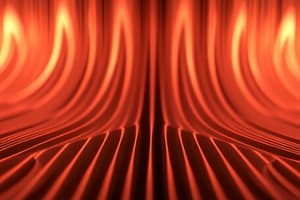Podcast
Questions and Answers
Explain the role of Huygens' principle in understanding wave behavior.
Explain the role of Huygens' principle in understanding wave behavior.
Huygens' principle allows scientists to explore the nature of light and other waves, as well as to predict and understand their behavior in various situations.
What is interference and how does it affect wave patterns?
What is interference and how does it affect wave patterns?
Interference is a phenomenon that occurs when two or more waves meet and combine, creating a new wave pattern that results from the superposition of the originating waves.
Describe the concept of diffraction in wave optics.
Describe the concept of diffraction in wave optics.
Diffraction is the bending or spreading of waves around obstacles or objects when waves encounter an aperture, edge, or other obstacle that interrupts the wavefront.
How do waves behave in Young's double slit experiment?
How do waves behave in Young's double slit experiment?
Explain why diffraction is considered a fundamental aspect of wave optics.
Explain why diffraction is considered a fundamental aspect of wave optics.
Study Notes
Wave Optics: Exploring Young's Double Slit, Huygens' Principle, Interference, and Diffraction
Wave optics is a cornerstone of modern physics, delving into the behavior of light as it travels and interacts within a medium, or even as a wave phenomenon itself. This article will explore some of the most significant concepts in wave optics, including Young's double slit experiment, Huygens' principle, interference, and diffraction.
Young's Double Slit Experiment
Named after its discoverer Thomas Young, the double slit experiment is a cornerstone of wave theory. In this experiment, light passes through two closely spaced slits, creating a pattern of bright and dark bands, known as interference fringes. The pattern emerges because each slit acts as a source of new waves, which then interfere with each other, resulting in a complex, systematic structure.
The beauty of the double slit experiment lies in its ability to demonstrate the fundamental nature of light as a wave, and the principle of superposition of waves. This experiment helped to usher in the era of wave-particle duality, where light and particles are observed to exhibit both wave and particle-like properties.
Huygens' Principle
Christiaan Huygens' principle is a cornerstone of wave mechanics, stating that every point on a wavefront can be considered as a source of secondary wavelets, and that the new wavefront can be constructed as the envelope of these wavelets.
In simple terms, this principle establishes a method for predicting the behavior of wavefronts and the propagation of waves. Huygens' principle allows scientists to explore the nature of light and other waves, as well as to predict and understand their behavior in various situations.
Interference
Interference is a phenomenon that occurs when two or more waves meet and combine, creating a new wave pattern that results from the superposition of the originating waves. This interaction can result in constructive interference, where the waves' amplitudes add to create a stronger wave, or destructive interference, where the waves' amplitudes cancel out, resulting in a weaker wave.
Interference is an essential concept in wave optics and demonstrates the fundamental principles of wave nature, superposition, and the principle of conservation of energy.
Diffraction
Diffraction is the bending or spreading of waves around obstacles or objects. This phenomenon occurs when waves encounter an aperture, edge, or other obstacle that interrupts the wavefront. In the case of light, diffraction results in the bending of light around corners, the formation of diffraction patterns, and the ability of light to be transmitted through very small openings, such as those in a double slit experiment.
Diffraction is a fundamental aspect of wave optics and helps to explain numerous manifestations of light, such as the diffraction of light passing through a slit or a grating, as well as the formation of optical instruments, such as lenses and mirrors.
In summary, wave optics is a vibrant field of physics that explores the behavior of light and other waves as they interact with each other and their environment. The concepts of Young's double slit experiment, Huygens' principle, interference, and diffraction are fundamental aspects of this field, providing us with a deep understanding of the fundamental nature of light and other waves and their interactions.
Studying That Suits You
Use AI to generate personalized quizzes and flashcards to suit your learning preferences.
Description
Dive into the fundamental concepts of wave optics including Young's double slit experiment, Huygens' principle, interference, and diffraction. Explore how light behaves as a wave, the principle of superposition, and the bending/spreading of waves around obstacles or objects.




